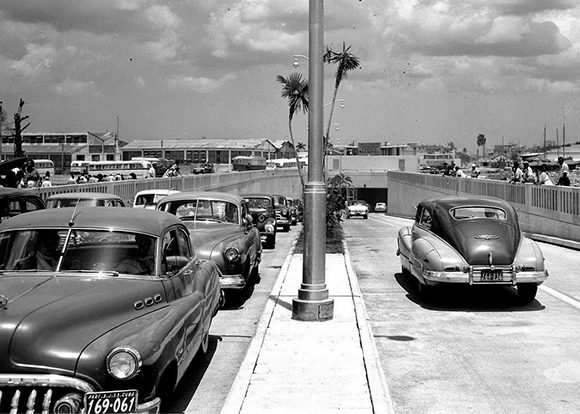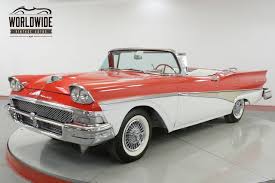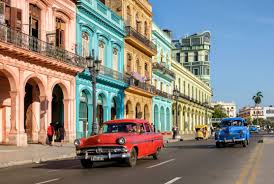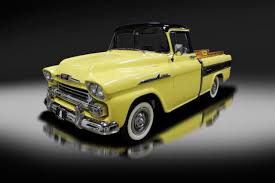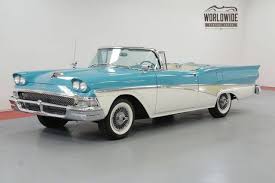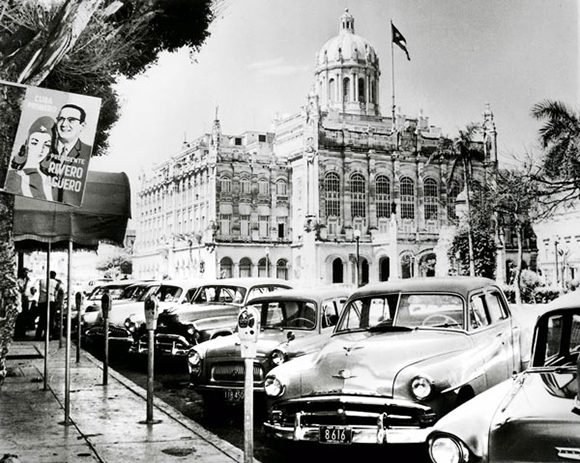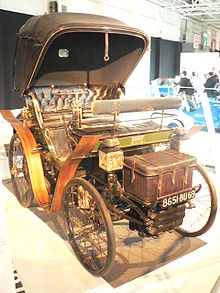 AUTOMOVILES EN CUBA, DESDE EL ROCHET-SCHNEIDER HASTA LOS “ALMENDRONES”.
AUTOMOVILES EN CUBA, DESDE EL ROCHET-SCHNEIDER HASTA LOS “ALMENDRONES”.
En 1958 Cuba era el sexto país del mundo en el promedio de automóviles por habitantes. La superaban, en este orden, EE.UU., Canadá, Gran Bretaña, Venezuela y Alemania Occidental.
Fue en el lejano mes de diciembre de 1898 cuando hizo su aparición en las polvorientas calles de La Habana un ruidoso automóvil que se movía con bencina y sólo podía desarrollar 10 Km/h. Era un Parisiense francés que había costado mil pesos a su dueño. Seis meses después llegó el segundo, un Rochet-Schneider venido de Lyón. Ese vehículo que perteneció al farmacéutico Ernesto Sarrá, tenía 8 caballos de fuerza y un costo de 4 mil pesos. Un tercer auto llegó poco tiempo después y se utilizó para distribuir la mercancía de una fábrica de cigarrillos existente en la ciudad.
Con el inicio del siglo llegaban también a Cuba el cine y la aviación, el tranvía eléctrico y el teléfono automático. Todo cambió de la noche a la mañana: del dominio español pasó el país a la dependencia de Estados Unidos. De la era de la tracción animal a la era de la combustión interna. De expresiones como “enganchar la pareja” a “sacar el automóvil”. De las riendas al freno de palancas o pedales y el timón.
En 1901 circulaban por las calles de La Habana once automóviles. Cuatro años después se expedían las primeras carteras dactilares, que entonces se llamaban títulos y que se exhibían, por sus portadores, como si se tratara diplomas universitarios. En 1906 ocurrió en La Habana el primer accidente automovilístico: un ciudadano murió luego de ser atropellado, en Monte y Ángeles, por el auto que conducía al presidente Estrada Palma. En 1917 se concedió por primera vez entre nosotros el permiso de conducir a una mujer. Correspondió a María Calvo Nodarse, la célebre Macorina, la de “ponme la mano aquí”. En 1930 comenzó a funcionar el primer semáforo del país.
Ya en la segunda mitad de la década de 1910 el coche de motor desplazaba a los vehículos de tracción animal. En 1913 circulaban por las calles de La Habana más de un millar de automóviles. En 1916, esa cifra sobrepasaba de tres mil. En 1959 circulaban en Cuba 180 511 autos, casi todos de procedencia norteamericana. Las estadísticas revelan que Chevrolet era la marca preferida por los cubanos. Seguía los vehículos marca Ford en la preferencia de los compradores, y más atrás las marcas Buick y Plymouth.
Pronto se había convertido Cuba en un paraíso para la industria automovilística norteamericana. En 1919 Cuba era ya el primer importador de automóviles en América Latina y uno de los primeros del mundo en la relación vehículos-habitantes. Eso motivó que en 1940 la empresa Ford decidiera que su sucursal en la Isla abarcara la mayoría de las agencias en las Antillas, controlada hasta entonces desde Panamá.
Pronto hubo en Cuba revistas, clubes y asociaciones vinculadas con el automóvil. Y temprano, muy temprano, comenzaron las carreras de autos. En 1903, Dámaso Lainez, propietario del primer servicentro que existió en Cuba —se localizaba en la calle Egido— convocó a la primera de ellas en el tramo Puente de La Lisa-Guanajay. Carrera esta que tuvo una particularidad: los competidores llevaban como copilotos a sus respectivas esposas. El vencedor fue Dámaso Lainez, el organizador del certamen. Fue el único concursante que dejó a la esposa en casa.
Dos años después, el 12 de febrero de 1905, se celebraba en Cuba por primera vez una carrera internacional en el tramo de Arroyo Arenas a San Cristóbal, con un recorrido de ida y vuelta de 158 Km. Para esta celebración vinieron a Cuba algunos de los corredores más famosos y los autos más potentes de la época, incluso algunos pilotos que habían impuesto récords mundiales. El ganador, sin embargo, fue el cubano Ernesto Carricaburu que nunca antes había participado en una competencia de ese tipo. Guiaba un auto Mercedes de sesenta caballos de fuerza e impuso una marca mundial de velocidad. Con el tiempo, Carricaburu fue el chofer oficial del presidente José Miguel Gómez, el primer mandatario cubano que sustituyó el coche de caballos por el vehículo de motor.
Hoy sorprende a los que nos visitan la cantidad de autos norteamericanos fabricados antes de 1959 que, gracias a la inventiva del cubano, circulan aún por las calles de la Isla. Es un museo rodante. Los Famosos “Almendrones Cubanos”, reliquias de un pasado mejor.
Existe en La Habana Vieja el Depósito del Automóvil, donde se exhiben ejemplares históricos, como un Cadillac 1905, el automóvil más antiguo que se conserva en Cuba, y el Chevrolet 1960 que utilizó Che Guevara. Otros automóviles sin embargo se los ha tragado el tiempo. Nada se sabe del destino de la cuña Packard del líder ortodoxo Eduardo Chibás, ni del Lincoln blindado del dictador Gerardo Machado.
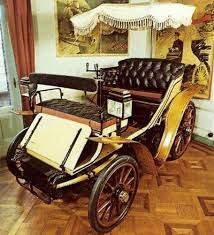 AUTOMOBILES IN CUBA, FROM THE ROCHET-SCHNEIDER TO THE “ALMENDRONES”.
AUTOMOBILES IN CUBA, FROM THE ROCHET-SCHNEIDER TO THE “ALMENDRONES”.
In 1958 Cuba was the sixth country in the world in the average of automobiles per inhabitants. It was surpassed, in this order, by the United States, Canada, Great Britain, Venezuela, and West Germany.
It was in the distant month of December 1898 when a noisy car that moved with gasoline and could only develop 10 km / h, made its appearance in the dusty streets of Havana. He was a French Parisian who had cost a thousand pesos to his owner. Six months later came the second, a Rochet-Schneider comes from Lyon. That vehicle that belonged to the pharmacist Ernesto Sarrá, had 8 horsepower and a cost of 4 thousand pesos. A third car arrived a short time later and was used to distribute merchandise from an existing cigarette factory in the city.
With the beginning of the century, cinema and aviation, the electric tram and the automatic telephone also arrived in Cuba. Everything changed overnight: from the Spanish domain the country passed to the dependence of the United States. From the era of animal traction to the era of the internal combustion. From expressions like “hook the couple” to “get the car.” From the reins to the brake of levers or pedals and the rudder.
In 1901 eleven cars circulated in the streets of Havana. Four years later, the first fingerprints were issued, which were then called titles and exhibited by their bearers, as if they were university diplomas. In 1906 the first car accident occurred in Havana: a citizen died after being run over, in Monte y Ángeles, by the car that drove President Estrada Palma. In 1917, a woman’s driving license was granted for the first time among us. It corresponded to Maria Calvo Nodarse, the famous Macorina, that of “put your hand here.” In 1930 the first traffic light in the country began to operate.
Already in the second half of the decade of 1910, the motor car displaced animal-drawn vehicles. In 1913 more than a thousand automobiles circulated through the streets of Havana. In 1916, that number surpassed three thousand. In 1959 there were 180 511 cars circulating in Cuba, almost all of the North American origin. Statistics reveal that Chevrolet was the brand preferred by Cubans. It followed the Ford vehicles in the buyers’ preference and further back the Buick and Plymouth brands.
Soon Cuba had become a paradise for the North American automobile industry. In 1919 Cuba was already the first importer of automobiles in Latin America and one of the first in the world in the vehicle-inhabitants relationship. That motivated that in 1940 the Ford company decided that its branch in the Island would cover most of the agencies in the Antilles, controlled until then from Panama.
Soon there were magazines, clubs, and associations related to the automobile in Cuba. And early, very early, car racing began. In 1903, Dámaso Lainez, owner of the first service that existed in Cuba -it was located on Egido street- called the first of them on the Puente de La Lisa-Guanajay section. A race that had a particularity: competitors took as co-drivers to their respective wives. The winner was Damaso Lainez, the organizer of the contest. He was the only contestant who left the wife at home.
Two years later, on February 12, 1905, an international race was held in Cuba for the first time on the stretch from Arroyo Arenas to San Cristóbal, with a round trip of 158 km. For this celebration, some of Cuba’s most famous riders and the most powerful cars of the time, including some riders who had set world records. The winner, however, was the Cuban Ernesto Carricaburu who had never participated in such a competition before. He was driving a sixty-horsepower Mercedes car and imposed a world speed mark. Over time, Carricaburu was the official driver of President José Miguel Gómez, the first Cuban president who replaced the horse carriage with the motor vehicle.
Today it surprises those who visit us the number of American cars manufactured before 1959 that, thanks to the inventiveness of the Cuban, still circulate through the streets of the island. It is a rolling museum. Relics of a better past.
There is the Automobile Depot in Old Havana, where historical specimens are exhibited, such as a 1905 Cadillac, the oldest car preserved in Cuba, and the 1960 Chevrolet used by Che Guevara. Other cars, however, have swallowed time. Nothing is known of the fate of the Packard wedge of the orthodox leader Eduardo Chibás, nor of the armored Lincoln of the dictator Gerardo Machado.
Agencies/ Lecturas/ Ciro Bianchi/ Internet Photos/ Arnoldo Varona/ www.TheCubanHistory.com
THE CUBAN HISTORY, HOLLYWOOD.



 < AUTOMOBILES in Cuba, from the Rochet-Schneider to the "Almendrones". Photos.
< AUTOMOBILES in Cuba, from the Rochet-Schneider to the "Almendrones". Photos.